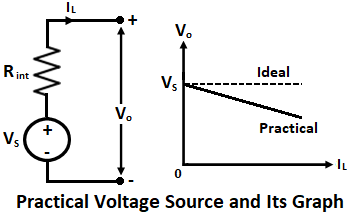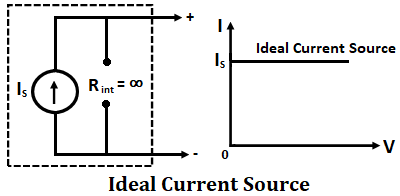A voltage source and a current source are two types of energy sources available in an electrical circuit. Both voltage and current sources are classified as active elements since they produce energy in the circuit. In this article, let us see the differences between a voltage source and a current source.
What is a Voltage Source?
A voltage source is a source of electrical energy that generates a specified voltage across its terminals. In other words, a voltage source establishes a potential difference across its terminal. We encounter voltage sources in our everyday life.
A voltage source is one of the most important active elements in a circuit. Some examples of voltage sources are batteries, dc generators, alternators, etc. There are two types of voltage sources, ideal and practical voltage sources.
Ideal Voltage Source :
An ideal voltage source is basically a constant voltage source that maintains a constant or fixed amount of voltage across its terminals no matter how much current is drawn from it. Thus the output of the ideal voltage source is independent of the load connected to it. Below shows the symbol representation and VI curve of an ideal voltage source.
The following are the properties of an ideal voltage source,- An ideal voltage source has zero internal resistance.
- An ideal voltage source always maintains a specified voltage across its terminal.
- The terminal voltage of the ideal voltage source remains constant even if the current drawn by the load varies.
Practical Voltage Source :
In practice, it is impossible to have an ideal voltage source. The output of a real or practical voltage source is dependent on the amount of current drawn by the load. All practical voltage sources have some internal resistance that causes some drop in voltage due to the flow of current.
Thus due to internal resistance the terminal voltage of a practical voltage source decreases when the load current increases and vice-versa. A practical voltage source can be represented by an ideal voltage source in series with a resistance whose value is equal to internal resistance as shown below.
The following are the properties of a practical voltage source,- A practical or real voltage source has finite internal resistance.
- The internal resistance causes a drop in voltage which depends upon the current drawn by the load.
- Due to internal resistance, the terminal voltage of a practical voltage source will be different from the actual source voltage.
- The practical voltage source is equivalent to an ideal voltage source in series with internal resistance.
What is a Current Source?
A current source is also a source of electrical energy that supplies current in the circuit. The current source is also considered an active element because it provides electrical energy in the circuit.
Some examples of current sources are photoelectric cells, collector current in transistors, etc. Similar to voltage sources, current sources are also classified into ideal and practical current sources.
Ideal Current Source :
An ideal current source is a constant current source that supplies same current regardless of voltage across it and the load connected to it. Since the current supplied by the ideal current source remains constant, the voltage across it depends on the value of the load connected to it. The symbol and V-I curve of the ideal current source is shown below. The arrow indicates the direction of the conventional current produced by the current source.
The following are the properties of an ideal current source,
- An ideal current source has infinite internal resistance.
- An ideal current source produces a specified current that is independent of the load and voltage across it.
Practical Current Source :
In reality, all current source has some drooping characteristics due to some internal resistance. A practical current source has some finite internal resistance due to which the current delivered into the circuit will not be constant. A practical current source is shown as an ideal current source in parallel with a resistance whose value is equal to internal resistance.
The following are the properties of a practical current source,
- A practical current source has high internal resistance.
- The current delivered by a practical current source depends on the voltage across it.
- The higher the internal resistance, the practical current source more closely reaches the ideal current source.
Differences between Voltage Source and Current Source :
| Voltage Source | Current Source | |
|---|---|---|
| Definition | A voltage source is a two-terminal circuit component that supplies voltage across its terminal continuously irrespective of the other circuit variables. | A current source is also a two-terminal circuit component that delivers continuous current regardless of the voltage and other circuit parameters. |
| Symbol | The signs represent the polarity of the voltage source. | The arrow represents the direction of the current supplied by the source. |
| Rating | Voltage sources are rated in Volts. | Current sources are rated in Amperes. |
| Ideal Source | An ideal voltage source has the capability to generate a constant voltage despite the amount of current drawn in the circuit. | An ideal current source delivers constant current independent of the voltage across the source. |
| Practical Source | The voltage of a real or practical voltage source is not constant but it decreases with an increase in load current. | The current of a real or practical current source is not constant but it decreases with an increase in voltage across it. |
| Internal Resistance | An ideal voltage source has zero internal resistance, but in reality, a voltage source has a finite internal resistance. | An ideal current source has infinite internal resistance, but a practical current source has finite internal resistance. |
| Internal Resistance Connection | Internal resistance is connected in series with the voltage source. | Internal resistance is connected in parallel with the current source. |
| Practical Source Representation | A practical voltage source is represented by an ideal voltage source with internal resistance in series. | A practical current source is represented by an ideal current source with internal resistance in parallel. |
| Parallel Connection | Voltage sources of only the same rating can be connected in parallel. | When current sources are connected in parallel the net current will be equal to the difference between the sum of the currents in one direction and the sum of currents in the opposite direction. |
| Series Connection | When voltage sources are connected in series resultant voltage will be either additive or subtractive depending upon the polarity of the voltage sources connected. | Current sources cannot be connected in series unless they have the same current rating. |
| Examples | Examples of voltage sources are batteries, dc generators, alternators, etc. | Examples of current sources are photovoltaic cells, collector currents of transistors, LED drivers, current regulators, etc. |






